
Your Introduction To Olympic Lifting!
Whether you use it to improve strength, muscle size, or power production, Olympic lifting has a lot to offer. Learn why and how to add the snatch and the clean and jerk to your training program!
The Olympic lifts seem to frighten a lot of everyday gym-goers, many of whom might not even know what these lifts are. Quite simply, the Olympic lifts are the snatch and the clean and jerk. Even if you don't plan to compete in Oly lifting, incorporating these lifts into your training program can not only help you gain more strength and muscle mass, but can make you an overall more athletic lifter.
People tend to shy away from the Olympic lifts because they look complicated and require a great deal of technique, but learning the lifts is absolutely worth it. Given a little time and practice, the Oly lifts can help you increase your squat and deadlifting technique, improve your explosive power, and lead to better coordination and flexibility.
In this article, I'll introduce you to the key benefits of Olympic lifting and help you get started with your own Oly lift training plan!
The Benefits of Olympic Lifting
Olympic lifting provides a great wealth of benefits in technique development, cardiovascular improvements, power production, and overall athletic ability that will positively affect other areas of your training, so be patient and enjoy the learning process!
Increased Muscle Mass and Bone Density
Olympic lifting (OL) is a staple component of many training programs used by professional athletes because it can increase muscle mass without interfering with speed and athletic performance. Several studies have even demonstrated increases in bone mineral density alongside increases in lean mass following an OL program.1,2
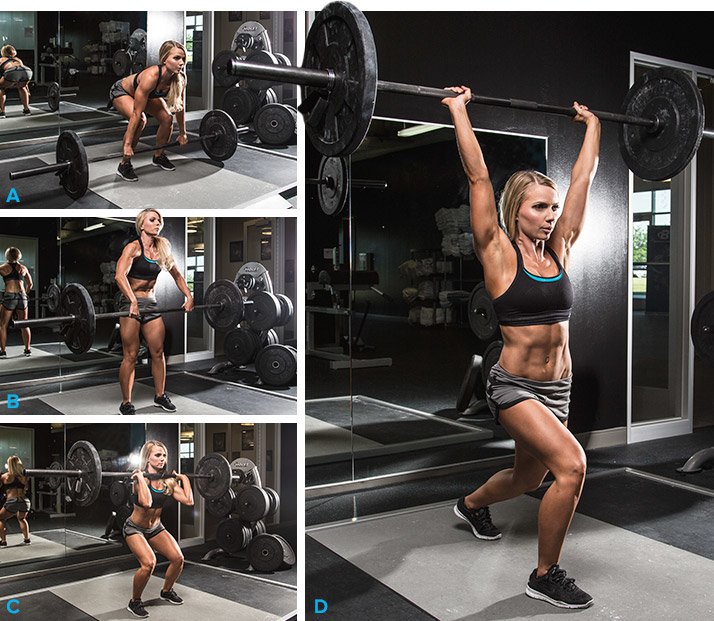
Clean and jerk
Improved Movement Proficiency and Technique
Olympic lifting is a technical training tool. There are only two main lifts—the clean and jerk and the snatch—yet people spend weeks, months, or even years training and working to perfect these movements.
Enhanced body awareness, mobility, and proper technique are important to developing movement proficiency and essential to Olympic lifting success. Technique-driven work in Olympic lift subcomponents, pulls, and transitions translates well into improved performance in traditional exercises like the squat and deadlift.
Increased Maximal Strength and Power
If building absolute strength and power and outperforming the competition is important to you, Olympic lifting is definitely worth considering. Olympic lifting increases force and power production more than traditional weightlifting or powerlifting alone.3 A study published in the Journal of Strength and Conditioning compared 15 weeks of Olympic lifting to powerlifting and found an 18 percent greater improvement in squat one-rep maxes for the Olympic lifting group.4
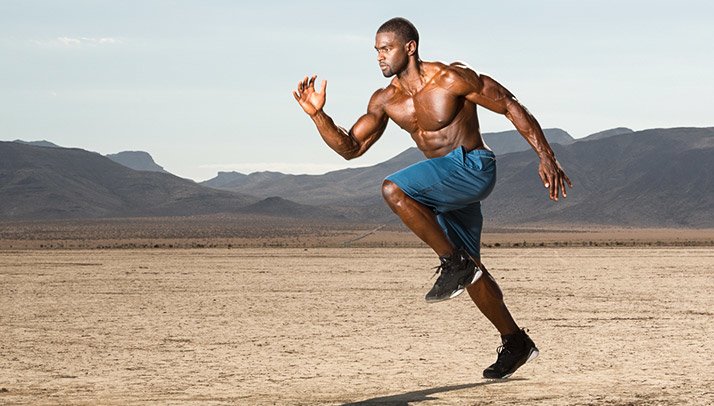
What good is strength if it doesn't translate well to physical performance? Research studies have shown significant improvements in sprint and vertical-jump performance by those who incorporate OL into their training.4,5 Olympic lifting brings about adaptations in power and promotes quickness above and beyond traditional weightlifting and powerlifting.3,6 This results in athletic-performance enhancement above what can be expected in other training models.
Increased Cardiovascular Response
The cardiovascular response to Olympic lifting is greater than that of traditional weightlifting regimens. Olympic lifting produces a superior cardiovascular response and activates more muscle mass with each repetition.1 OL training has been shown to increase maximal oxygen consumption (VO2max) and decrease resting heart rate—two adaptations you typically only see with endurance training.6,7
Increased muscle activation and cardiovascular response translates into a more efficient workout and potentially means that you don't have to dedicate as much time to cardio.
Getting Started
Rather than replacing your current program with a strictly OL program, just incorporate a couple of Olympic-lift days into your traditional weightlifting program each week. It won't be long before you start to reap the benefits!
Here are a few more tips to get you started:
Find a Coach
Olympic lifting has become more and more common in gyms and fitness facilities nationwide over the past 5-10 years, so getting started isn't as difficult as it once was. It's important to be patient, find a coach or a beginner class, and become a student of OL technique. Coaching and beginner classes can often be found at local gyms or CrossFit boxes.
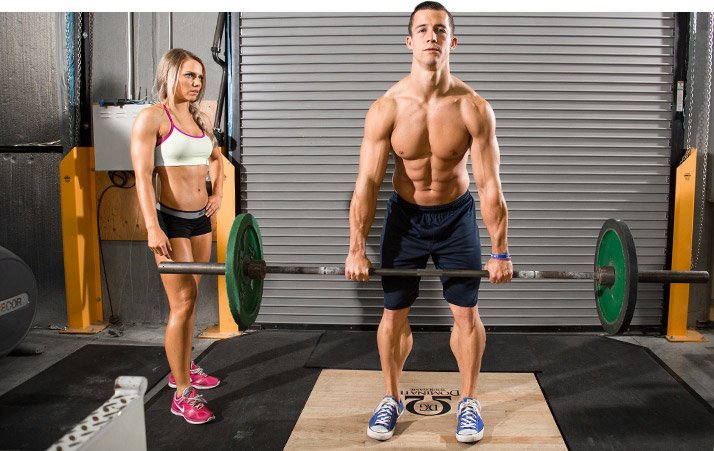
When seeking a coach or joining a class, try to find an expert in your area that maintains USA Weightlifting, National Strength and Conditioning Association Certified Strength and Conditioning Specialist (CSCS), or CrossFit lifting certifications. Certified coaches may vary in philosophy and coaching style, so find one that works best for you.
Play It Safe
Olympic lifting is very technical. Small details involved in these lifts are important and will challenge you to become more aware of yourself and your movement patterns, which is sure to help you in other areas of your fitness. The lifts involve complex, compound movements, completed in seconds or fractions of seconds.
Therefore, safety is crucial. Find a class or coach, and budget some time for consistent practice before flying solo. Most introduction programs will be minimum of 2-3 days per week. Olympic lifting can be completed safely, but it is important to keep your ego subdued as you learn.
Progress Properly
Technique and form are critical to a successful OL career. Much of the initial work completed in beginner training will involve lightweight PVC, a wooden dowel, or even a broom handle before graduating to an empty barbell and eventually adding weight. Frequently, these lifts are learned in pieces and then put together into a fluid athletic movement. Start with the basic movements, and progress from there. It is vital to have proper technique before progressing in Olympic lifting.
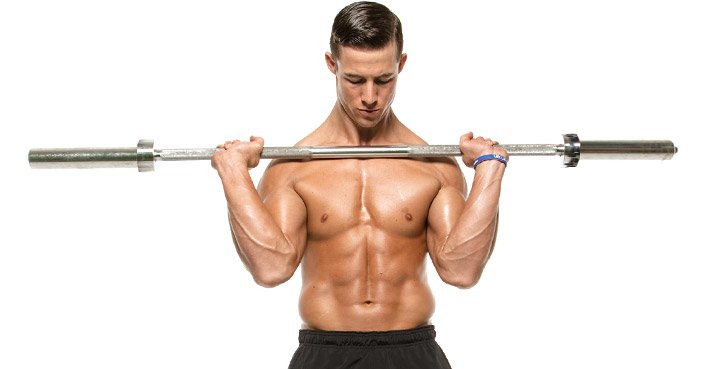
A good rule of thumb is to only make modest increases in weight after you're confident and successful with a particular weight for at least two training sessions, hitting target sets and reps with consistency and with correct form. I also recommend that you have someone you trust critique your lifts or videotape them so you can analyze your form prior to increasing weight.
Online articles, e-books, and videos can provide great information and complement your coach's instruction. Take advantage of free resources where you can to help you while you learn the basics.
Strive for these Benchmarks
In traditional weightlifting, we typically give the goal of a 1RM equal to twice your body weight for squats and deadlifts. This is something both achievable and respectable as training experience increases. Experienced Olympic lifters and elite athletes will likely be able to perform Olympic lifts at twice their body weight, but you don't need to hit those numbers to get the benefits discussed above.
Technical components, precision, and raw power required to move barbells through space at high velocities mean you may be a little disappointed with the amount of weight you can put over your head. However, a respectable clean and jerk or snatch for an amateur lifter is body weight or slightly above. If you weigh 180 pounds, a clean and jerk of 180-200 pounds is a respectable accomplishment!
Practice, Practice, Practice
Generally, the Olympic lifts can be learned in several weeks to a few months. Dedicating an hour or less of your training to Olympic lifting and technique 2-3 times per week will get you there.
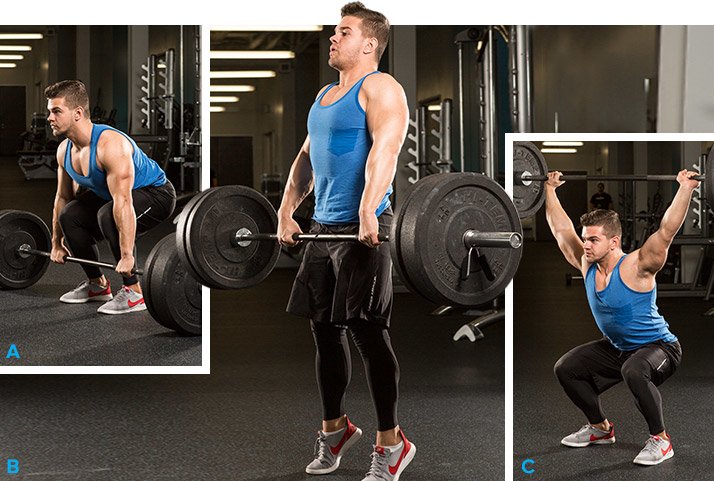
Snatch
There is a reciprocal relationship between traditional weightlifting and Olympic lifting. Incorporating OL in your training will likely help boost your traditional lift numbers, and improving your squat, deadlift, and presses can help expedite your OL success.
Due to the technical demands of OL, the snatch and clean and jerk may be slower to progress, and your PRs will likely be lower than your squat or deadlift numbers. Although the training emphasis is different, the benefits are maximized when combined into a well-formulated training program.
References
- Garhammer, J. O. H. N. (1979). Power production by Olympic weightlifters. Medicine and Science in Sports and Exercise, 12 (1), 54-60.
- Kanehisa, H., Ikegawa, S., & Fukunaga, T. (1998). Body composition and cross-sectional areas of limb lean tissues in Olympic weight lifters. Scandinavian Journal of Medicine & Science in Sports, 8 (5), 271-278.
- McBride, J. M., Triplett-McBride T., Davie, A., & Newton, R. U. (1999). A Comparison of Strength and Power Characteristics Between Power Lifters, Olympic Lifters, and Sprinters. The Journal of Strength & Conditioning Research, 13 (1), 58-66.
- Hoffman, J. R., Cooper, J., Wendell, M., & Kang, J. (2004). Comparison of Olympic vs. traditional power lifting training programs in football players. The Journal of Strength & Conditioning Research, 18 (1), 129-135.
- Tricoli, V., Lamas, L., Carnevale, R., & Ugrinowitsch, C. (2005). Short-term effects on lower-body functional power development: weightlifting vs. vertical jump training programs. The Journal of Strength & Conditioning Research,19 (2), 433-437.
- Komi, P. (Ed.). (2008). The Encyclopaedia of Sports Medicine: An IOC Medical Commission Publication, Strength and Power in Sport (Vol. 3). John Wiley & Sons.
- Stone, M. H., Wilson, G. D., Blessing, D., & Rozenek, R. (1983). Cardiovascular responses to short-term olympic style weight-training in young men. Canadian journal of applied sport sciences. Journal Canadien des Sciences Appliquees au Sport, 8 (3), 134-139.
